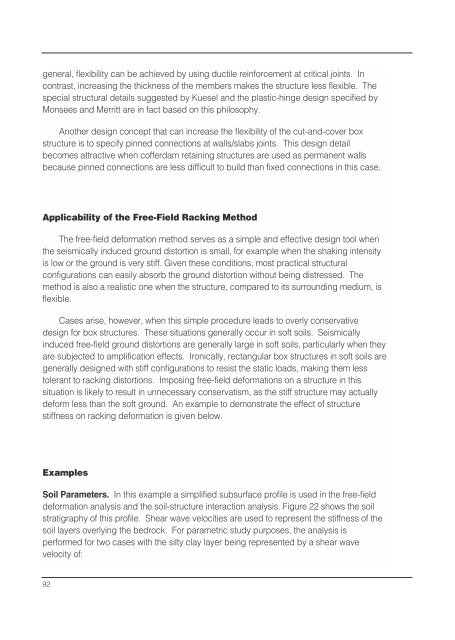Seismic Design of Tunnels - Parsons Brinckerhoff
Seismic Design of Tunnels - Parsons Brinckerhoff
Seismic Design of Tunnels - Parsons Brinckerhoff
You also want an ePaper? Increase the reach of your titles
YUMPU automatically turns print PDFs into web optimized ePapers that Google loves.
general, flexibility can be achieved by using ductile reinforcement at critical joints. In<br />
contrast, increasing the thickness <strong>of</strong> the members makes the structure less flexible. The<br />
special structural details suggested by Kuesel and the plastic-hinge design specified by<br />
Monsees and Merritt are in fact based on this philosophy.<br />
Another design concept that can increase the flexibility <strong>of</strong> the cut-and-cover box<br />
structure is to specify pinned connections at walls/slabs joints. This design detail<br />
becomes attractive when c<strong>of</strong>ferdam retaining structures are used as permanent walls<br />
because pinned connections are less difficult to build than fixed connections in this case.<br />
Applicability <strong>of</strong> the Free-Field Racking Method<br />
The free-field deformation method serves as a simple and effective design tool when<br />
the seismically induced ground distortion is small, for example when the shaking intensity<br />
is low or the ground is very stiff. Given these conditions, most practical structural<br />
configurations can easily absorb the ground distortion without being distressed. The<br />
method is also a realistic one when the structure, compared to its surrounding medium, is<br />
flexible.<br />
Cases arise, however, when this simple procedure leads to overly conservative<br />
design for box structures. These situations generally occur in s<strong>of</strong>t soils. <strong>Seismic</strong>ally<br />
induced free-field ground distortions are generally large in s<strong>of</strong>t soils, particularly when they<br />
are subjected to amplification effects. Ironically, rectangular box structures in s<strong>of</strong>t soils are<br />
generally designed with stiff configurations to resist the static loads, making them less<br />
tolerant to racking distortions. Imposing free-field deformations on a structure in this<br />
situation is likely to result in unnecessary conservatism, as the stiff structure may actually<br />
deform less than the s<strong>of</strong>t ground. An example to demonstrate the effect <strong>of</strong> structure<br />
stiffness on racking deformation is given below.<br />
Examples<br />
Soil Parameters. In this example a simplified subsurface pr<strong>of</strong>ile is used in the free-field<br />
deformation analysis and the soil-structure interaction analysis. Figure 22 shows the soil<br />
stratigraphy <strong>of</strong> this pr<strong>of</strong>ile. Shear wave velocities are used to represent the stiffness <strong>of</strong> the<br />
soil layers overlying the bedrock. For parametric study purposes, the analysis is<br />
performed for two cases with the silty clay layer being represented by a shear wave<br />
velocity <strong>of</strong>:<br />
92
















